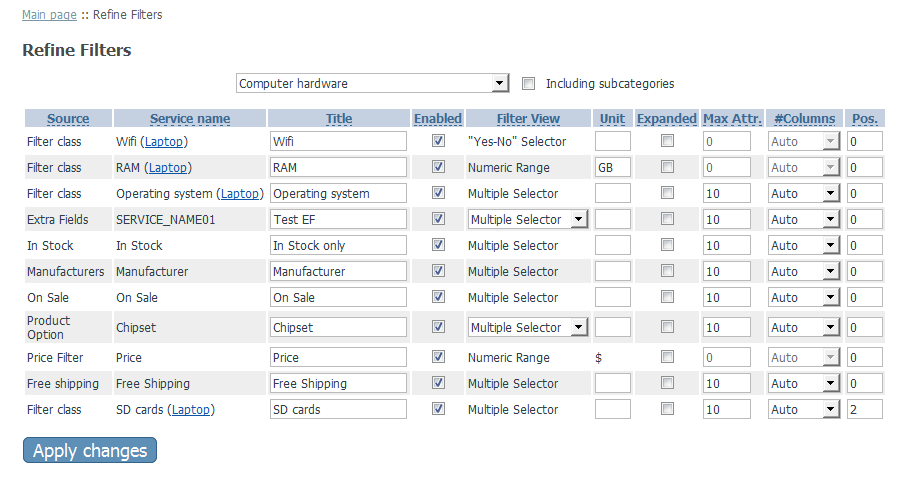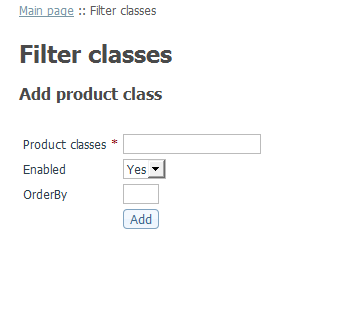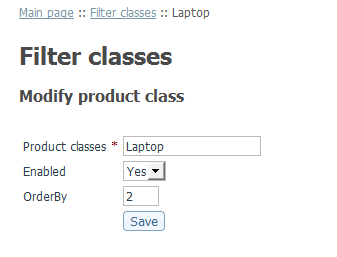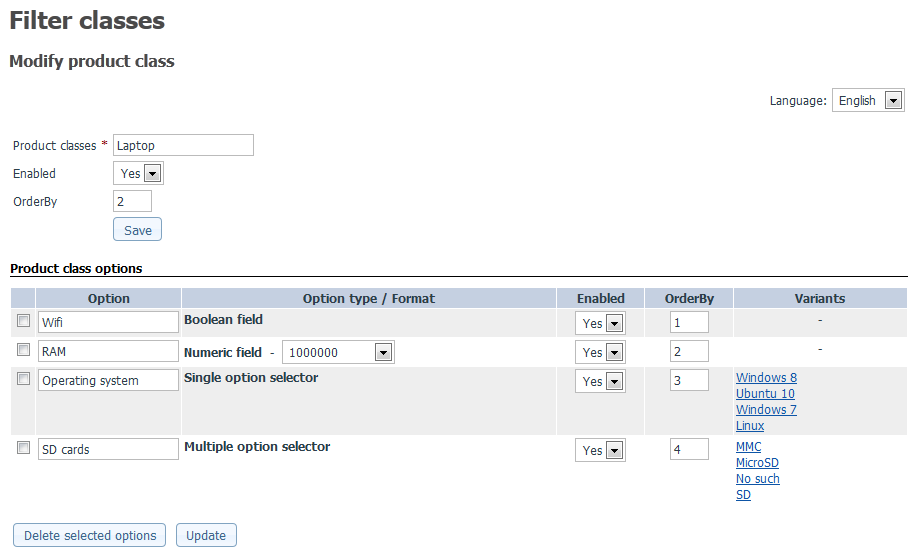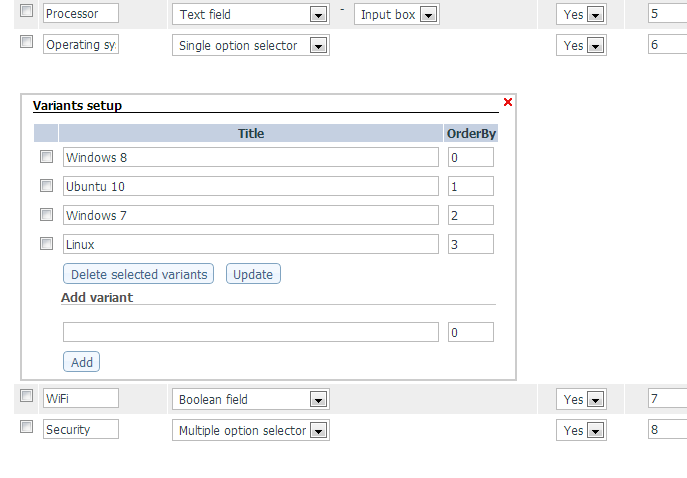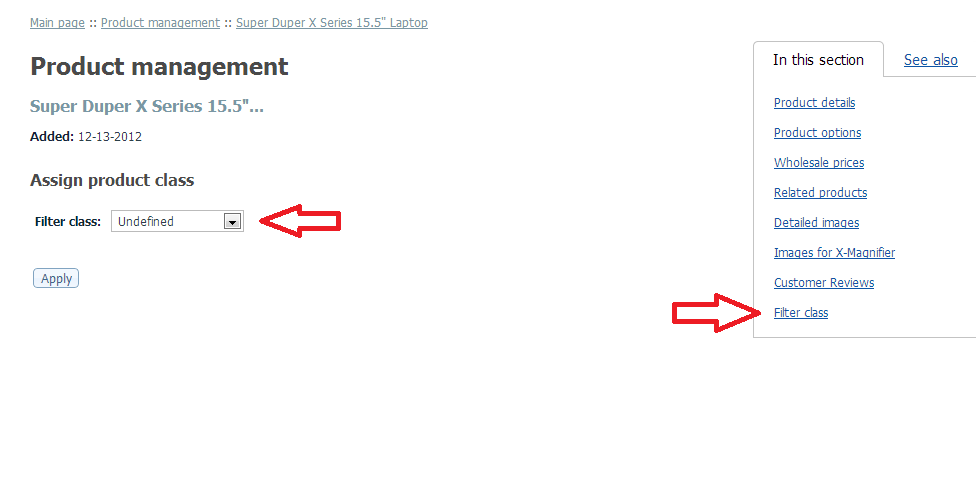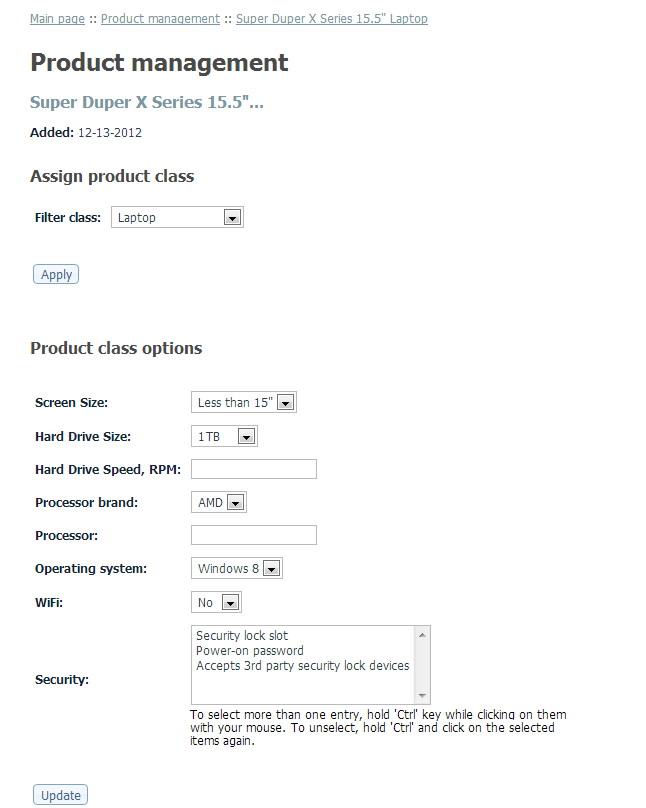X-Cart:Refine Filters
Contents
Overview
What Refine Filters does
"Refine Filters" enables your customers to use parametric search to easily find what they need. Help your customers stop looking for a needle in a haystack with X-Cart’s Refine Filters module.
Refine Filters offers a brand new way of navigating your store that allows customers to quickly find exactly what they need. Working from your existing product options, variants, feature comparison classes and more, Refine Filters generates radio buttons and numeric sliders and even allows for multiple selections to help your customers narrow a products list down to what fits their needs.
Why Refine Filters?
Imagine navigating hundreds or even thousands of similar-looking medicines or auto parts to find the one you need. With Refine Filters, your customers can leave the nightmare behind and find what they are looking for in just several clicks—increasing sales conversions, generating add-on sales and lowering your customer service workload.
System requirements
To be able to successfully install and use the Refine Filters module, you must have a working copy of X-Cart GOLD or GOLD PLUS version 4.5.0 or later installed on your server. Make sure that the version of the module is the same as the version of the installed copy of X-Cart.
Installation
To install the module:
- Obtain a distribution package for the Refine Filters add-on module by downloading it from the File Area section of your X-Cart Account. The distribution package you need is contained in the archive file x-refine-filters-x.y.z.tgz where x, y and z are the version numbers of the module. Make sure the version of the module is the same as the version of the installed X-Cart.
- Copy the distribution package to the X-Cart root directory on your server or hosting account.
- If you are using a Windows-based server, or a UNIX-based server without terminal access:
- a) Decompress the archive with the Refine Filters distribution package to a directory on your system using your favorite compression program (WinZIP or any other archiver with support for TAR files).
- b) Use an FTP client to upload all the files contained in the archive (retaining the directory structure) to the X-Cart root directory on your server or your hosting account.
- If you are using a UNIX-based server with terminal access:
- a) Use an FTP client to upload the archive with the distribution package to the X-Cart root directory on your server or your hosting account.
- b) Decompress the package using the following command:
tar -xzvf x-refine-filters-x.y.z.tgz
- Important: Make sure you keep the directory structure while unpacking and uploading the distribution package, otherwise some necessary files can be overwritten!
- In a web browser, run the installation script httр://<YOUR_XCART_DOMAIN>/install-x-refine-filters.php replacing the variable <YOUR_XCART_DOMAIN> with the actual domain name of your X-Cart store.
- Enter the Auth code, accept the License Agreement and click Next.
- The installation script patches the files and activates the module. Click Next to continue the installation.Note: if you are using custom skin, you will need to manually apply the patches to it. Otherwise, the module will not work in this skin.
- The installation script generates a new system fingerprint. Click Next to complete the installation.
- Use the ADMINISTRATOR AREA link to log in to the Admin area.
Enabling Refine Filters add-on module
After the Refine Filters add-on module installation has been completed, the module is enabled and working. If you want to disable/enable the module please do the following:
1. In Admin area, go to the Modules section (Settings menu->Modules). 2. Choose the Refine Filters module by selecting/unselecting the respective check box on the left. 3. Click the Apply changes button. This activates/deactivates the module.
Configuring Refine Filters add-on module
In Admin area, go to the Modules section (Settings menu->Modules). Then find Refine Filters row and click “Configure” link. You will see various module settings there:
General section
- Enable dynamic filtering (this may slow down your server): enable/disable dynamic filtering, i.e. dynamically grays out some filters attributes basing on already selected attributes.
- Max number of categories in search results (0 - unlimited): this option is applicable for filters at search results and manufacturers pages only.
- New filters are enabled by default: all newly generated filters are enabled for all categories.
- New filters are expanded by default: all newly generated filters are expanded for all categories
Data Sources section
This section allows you to enable/disable data sources filters are generated on. For example, you may disable all but extra fields so your filters are generated basing on extra fields only and other data sources such as product options and Feature Comparison classes are no used. There are also options for special filters like "Free shipping". By unticking corresponding checkbos you may hide this filter.
This section controls filters globally for all categories. If you need to show a filter for certain category and hide it for other categories, you may do it at Refine Filters page (see below).
Appearance section
- Display filters on category page
- Display filters on search results
- Display filters on manufacturers page
These 3 options controls where to display a refine filters: at the category page, at the search results page and at the manufacturers page respectively.
- Show filters classes info at product details: this option displays defined filter classes on the product details page in customer front-end.
- Show dynamic range for sliders: applicable only when dynamic filtering is enabled. By default, there is a blue bar on the numeric sliders which shows actual numeric range for the filtered products. By turning this option off you can hide such blue bar and thus simplify sliders a bit.
- Disable checkboxes for unavailable attributes in dynamic filtering: applicable only when dynamic filtering is enabled. Filters attributes which are not available for filtered products will be gray-out, but corresponding checkboxes will not be disabled (thus allowing to result in "0 products found" if selected). If you want to disable checkboxes for not available attributes please turn this option on.
Once you adjusted module configuration don’t forget to click Apply changes to save the changes.
Managing Refine Filters
Filters can be configured at the ‘Refine Filters’ page in the admin back-end. This page can be accessed by clicking the Refine Filters link in the Catalog menu.
Once you open this page - you will see category selector:
All refine filters are tied to categories. Even though filters are displayed at the search results and at a manufacturer products pages, customer will always see filters for either the most popular category (for current search criteria) or will have to choose a category to see filters.
To manage a category filters, select the category in the dropdown:
By default it’s prefilled with automatically created filters, you can enable/disable it and adjust appearance and other settings for each filter in the category. By clicking “Including subcategories” checkbox you may spread the filters to all subcategories of the chosen category.
Filters table has the following columns:
- Source - source of a filter. By default all filters are enabled, but you can globally turn some filters off on the “Refine filters module settings page -> Data sources” section
- Service name - service name of a filter. This is an unique identicator of a particular data source (e.g. service name of an extra field, class name of a product option &etc.)
- Title - display name of a filter. This values is shown to customers as a title for a filter.
- Enabled - allows to enable/disable a filter.
- Filter view - visual representation of the filter for customer. There are 3 type of filters: “Multiple selector”, “Yes-No selector”, “Numeric range (slider)”.
- Unit - allows to set the dimension of a numeric value here like "cm", "in", "gr" etc. Applicable for “Numeric range” filters only.
- Expanded - allows to choose wether a filter is expanded or not on the first page load. If a filter is not expanded by default, it's attributes are not shown to customers (so they need to expand it first) but you may save some screen space.
- Max attrs - allows to set a maximun number of attributes displayed before it starts to show “More...” link. Applicable for “Multiple selector” filters only.
- Columns - allows to define a number of columns to display attributes in. If you have long attribute names, you’ll probably want to set it to 1-column. But if you have a lot of short-named attributes, you'd rather choose 2 columns. Applicable for “Multiple selector” filters only.
- Pos - position of a filter in the filters list in customer area.
Managing filter classes for filters
Filter classes overview
Filter classes can be used to set additional properties (attributes) to products. It’s working like Products classes in the Feature Comparision module.
Adding, updating and deleting filter classes
Filter classes can be defined in the ‘Filter classes’ section of the store. This section can be accessed by clicking the Filter classes link in the Catalog menu.
To create a new product class:
- Click the ‘Add product class’ link in the section menu. The ‘Add product class’ form will appear.
- Enter a title for the product class into the ‘Product class’ field.
- Specify whether the class is enabled by selecting Yes or No from the ‘Enabled’selectbox.
- Specify the position number of the product class in the list of product classes (‘OrderBy’ field).
- Click on ‘Add’. As soon as the product class is created, you will be informed about it by a message in the ‘Information’ box.
After the creation of the new product class, you can see another form appearing in the place of the ‘Add product class’ form. This new form is titled ‘Modify product class’.
This form allows you to modify the details of the product class you have just created (if necessary) and to define product class options (features) for it. You can turn to modifying the product class details (image, title, availability, or OrderBy position number) and defining product class options (features) at once, or put it off till later (The ‘Modify product class’ form can be accessed at any time by clicking on the title of the product class which you want to modify in the ‘Product classes’ form). To find out how to modify a product class, please refer to the ‘Modifying product classes’ section of this User guide.
To add more filter classes, use the ‘Add product class’ button on the filters classes page.
You can change the availability status of your product classes and the order in which they are displayed right in the ‘Product classes’ form. To do so, select Yes or No from the ENABLED selectbox, change the product class position number in the OrderBy field opposite the title of the appropriate product class and click on Update. The changes will be saved.
To delete a filter class, select the check box next to the title of the product class you would like to delete and click on ‘Delete selected’. The filter class will be removed from the list. (You can use the Check all / Uncheck all links to select or unselect all the check boxes).
Modifying filter class details
To modify the details of a product class:
1. Open the ‘Modify product class’ form.
2. If necessary, change the filter class title, availability status and OrderBy position number. 3. Click on ‘Save’.
Modifying filter class options
To define product class options:
1. Open the ‘Modify product class’ form. Scroll down to the ‘Product class options’ section of the form.
2. Use the ‘Add new option’ subsection to add product class options:
- Enter a name for the new option (Option column).
- Use the selectbox in the Option type/Format column to select the option type see “Notes on option types” section for option types notes
- Select Yes or No from the selectbox in the Enabled column to specify whether the feature should be displayed to customers or not.
- Enter a position number of the option in the list of product class options (OrderBy column).
- If applicable, specify available variants for the option being created: enter the variant names in a column, each variant starting from a new line (Variants column).
- Click on ‘Add’. The option will be created and added to the list of options in the ‘Product class options’ section of the form.
- If applicable, specify the format in which concrete values of the option should be displayed (Option type/Format column, below the option type selectbox). Click on ‘Update’.
- Repeat these steps a-h to add more product class options.
To delete product class options (features):
- In the ‘Product class options’ section select the check boxes next to the names of the product class options which you want to delete.
- Click on 'Delete selected options'
To modify product class options (features):
- In the ‘Product class options’ section of the ‘Modify product class’ form change the necessary product class options’ settings.
- Click on ‘Update'’
To modify the variants of a product class option:
- In the ‘Product class options’ section of the ‘Modify product class’ form click on the option variants which you want to modify. The ‘Variants setup’ box will appears:
- Use the ‘Variants setup’ box to modify the contents of the variants section:
- To rename one or more of the existing variants, change the names of the variants you want to rename and click on ‘Update’.
- To delete one or more of the existing variants, select the check boxes next to the names of the variants you want to delete and click on ‘Delete selected variants’.
- To add a new variant to the list, enter a name for the new variant in the ‘Add variant’ subsection and click on ‘Add’.
- Click on the X (‘Close’ sign) in the top right corner of the ‘Variants setup’ box. The box will be closed.
Notes on option types
Filter classes supports the following option types:
- Text field
- Single option selector
- Multiple option selector
- Numeric field
- Boolean field
- Date field
These types determine the way in which providers and customers will be able to input data into the fields corresponding to product class options.
Text field is a simple text field into which custom text can be entered. Any characters entered into a field of this type are regarded as text. This option type requires the option field format to be specified (Input box or Text area, depending on the amount of text that needs to be entered).
Single option selector is a field displaying a predefined set of values from which only one can be selected. This option type requires variants to be provided.
Multiple option selector is a field displaying a predefined set of values from which several values can be selected. This option type requires variants to be provided.
Numeric field is a field that allows users to enter numeric values so they are treated as numbers (which allows customers to search for products using number ranges). This option type requires the option field format to be specified.
Boolean field is a field from which only one of the two values can be chosen: Yes or No (signifies presence or absence of some feature).
Date field is a field that allows users to enter dates. This option type requires the option field format to be specified.
Assigning filter classes to products
After the necessary product classes have been defined, they need to be assigned to the products for which you want to allow comparison.
To assign a product class to some product:
1. Find the product and open it for modification.
2. Click the ‘Filter class’ link in the section menu.
‘Assign filter class’ form will appear. As the product has not been assigned to any product class yet, ‘Undefined’ appears in the ‘Product class’ selectbox.
3. Use the selectbox to select the product class to which you want the product being modified to be assigned.
4. Click on ‘Apply’. The product class will be assigned. The ‘Product class options’ form will appear below the ‘Assign product class’ form (The set of fields in the ‘Product class options’ form corresponds to the product class selected for the product).
5. Use the option fields in the ‘Product class options’ form to assign the necessary option values to the product being modified.
6. Click on ‘Update’. The changes will be applied.

